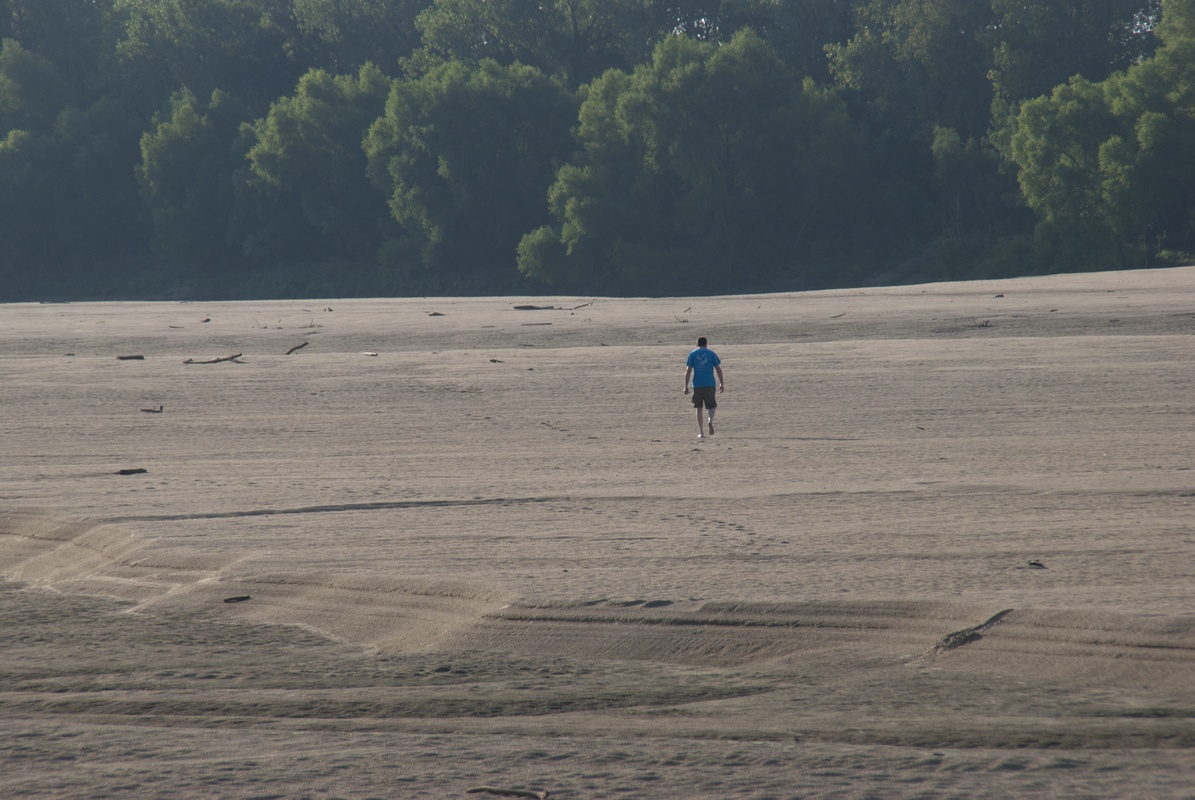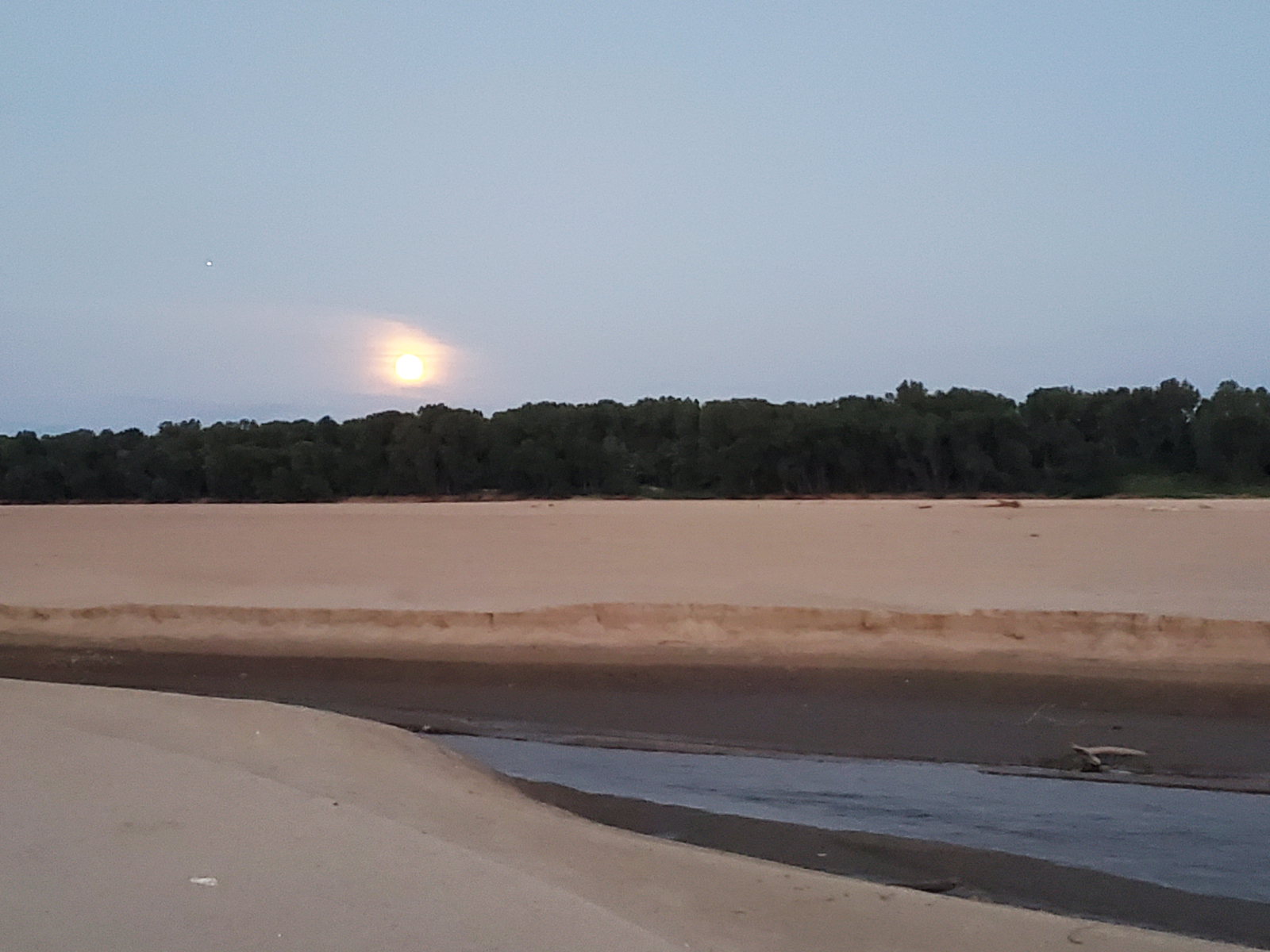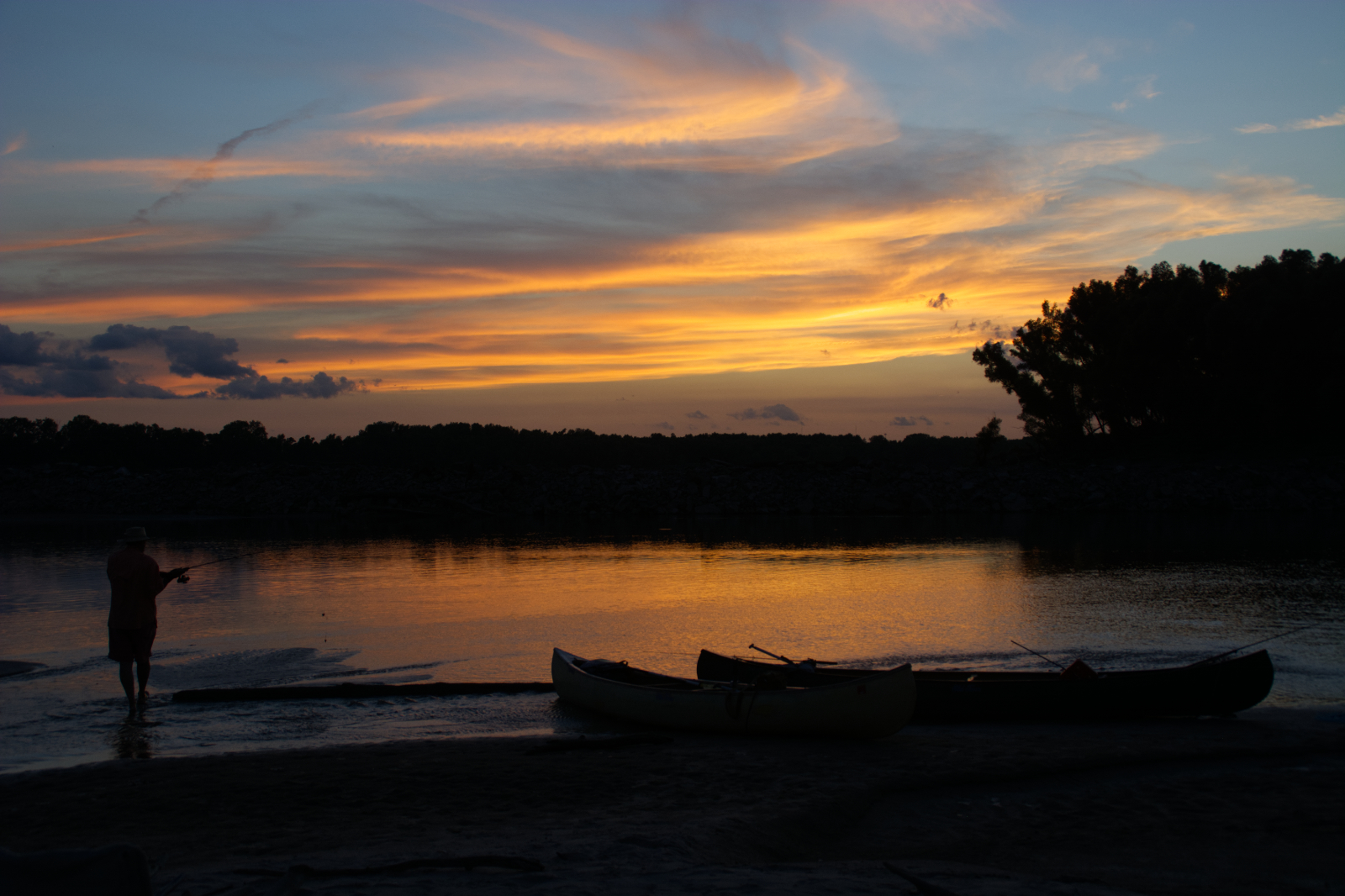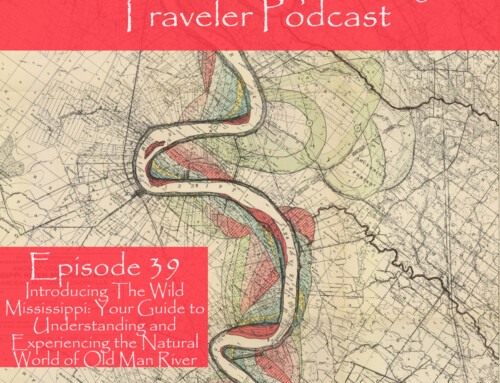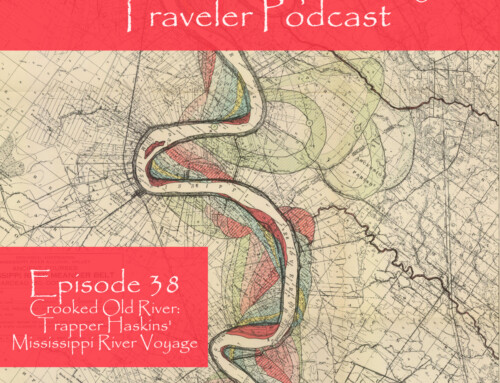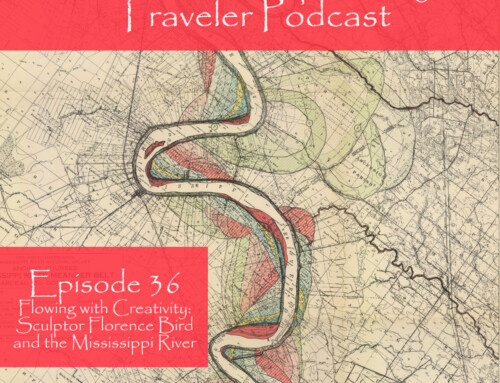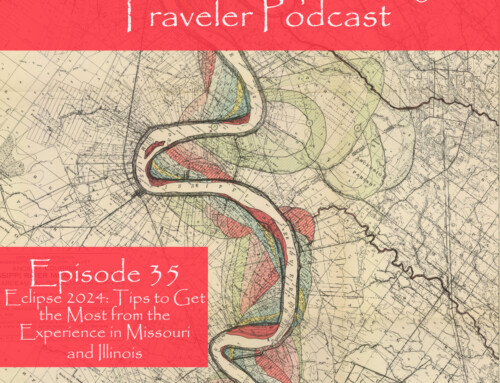The Mississippi River is polluted! It’s for barges only. Dams on the upper river were built for flood control. These are a few of the myths about the Mississippi that persist. In this episode, Klinkenberg will tackle these and other mistaken beliefs about the Mississippi.
Show Notes
People have lived along the Mississippi River for thousands of years, and they all had their own way of referring to the river, although many of those words have been lost to time. The Ojibwe people in northern Minnesota had words for the river overall and for specific parts of the river, place markers, basically. We do the same thing today. Along the upper part of the river, you’ll often hear people say they live along Pool 9, or some other number, referring to the body of water behind one of the navigation dams. These are some of the Ojibwe words, as researched by the park rangers at Itasca State Park in Minnesota:
- Wab-a-sa’-di-kank (at the white poplar place): between Lake Itasca and Lake Irving
- Wub’-i-gum-ag zi’-bi (the river of the lake that has a constrictive place): the short channel that connects Lakes Irving and Bemidji
- Be’-mi-dji’-gum-ag za’-gai’-i-gun (the lake across which the current flows diagonally)
- Gaa-miskwaawaakokaag-ziibi: from Cass Lake to Lake Winnie the river (Red Cedar River)
- Wiinibiigoozhish-ziibi: From Lake Winnibigoshish (Miserable Wretched Dirty Water River)
- Pindj’-dji’-bon-na’-gun-ink (in the fish trap): before Wolf Lake
- Wub’-it-i-give’-ya-zi’bi (the river that flows through the narrow constricted place): between Lake Andrusia and Cass Lake
- Gi-no-i-zhe-a-we-yank (at the long reach of the river): between lakes Cass and Winnibigoshish
- Ueshk’-i-bwa-kan–ing (at the place of artichokes): a spot between lakes Cass and Winnibigoshish
- Kish-ki-ta’-wang’-ag (at the cut steep sandy banks): just before Lake Winnibigoshish
- Wi-ni-bi’-goh-ish zi-bi (miserable dirty water river): Big Winnie outlet
Other Native American communities had their own names for the river. Here are a few examples posted at the Decolonial Atlas website:
- Báhat Sássin – (Hasí:nay [Caddo]), “Mother of rivers”
- Beesniicíe – (Hinónoʼeitíít [Arapaho])
- Ȟaȟáwakpa – (Lakȟótiyapi [Lakota]), “River of the falls”
- Kickaátit – (Paári [Pawnee])
- Mäse’sibowi – (Meshkwahkihaki [Fox-Sauk])
- Ma’xeé’ome’tää’e – (Tsėhésenėstsestȯtse [Cheyenne]), “Big, greasy river”
- Mihcisiipiiwi – (Myaamia [Miami-Illinois])
- Misha Sipokni – (Chahta’ [Choctaw]), “Beyond age”
- Ny-tonks – (Okáxpa íe [Quapaw]), “Great river”
- Uhtawiyúˀkye – (Ska:rù:rę’ [Tuscarora])
- Yandawezue – (Waⁿdat [Wyandot])
- Xósáu – (Cáuijògà [Kiowa]), “Standing Rocks”
Here’s a few pictures of Moro Island:
Support the Show
If you are enjoying the podcast, please consider showing your support by making a one-time contribution or by supporting as a regular contributor through Patreon. Every dollar you contribute makes it possible for me to continue sharing stories about America’s Greatest River.
Transcript
Dean (00:00):
The Mississippi River is polluted. It’s dangerous. It’s only for barges. Hog wash. Join me today. As we do some myth busting about the Mississippi.
Dean (00:27):
Welcome to the Mississippi Valley Traveler podcast. I’m Dean Klinkenberg, and I’ve been exploring the deep history and rich culture of the people and places along America’s greatest river, the Mississippi, since 2007. Join me as I go deep into the characters and places along the river, and occasionally wander into other stories from the Midwest and other rivers. Read the episode show notes and get more information on the Mississippi at MississippiValleyTraveler.com. Let’s get going.
New Speaker (00:58):
Hey folks, and welcome to episode three of the Mississippi Valley Traveler podcast. Today we’re gonna take on some of the persistent myths that people still believe about our great river. There are just some of the beliefs about the Mississippi that people have a hard time letting go of, or are just get passed around so often that people just keep believing them. So I’m gonna take on a few of these myths head on today and I’ll tell you why they’re just not true. So let’s get going.
Dean (01:38):
The first myth I’m gonna tackle is this idea that the dams along the Mississippi, along the upper part of the river, provide some kind of flood protection. So let’s get a little background here. There are 29 dams along the upper half of the river between Minneapolis and St. Louis. Most of them were built between 1930 and 1940 as part of Franklin Roosevelt’s New Deal programs during the Great Depression. Construction of the dams at that time was entirely funded by taxpayers and managed through the US Army Corps of Engineers, which still manages navigation, flood control… basically still manages the Mississippi today. There are a few dams that were built a little outside of that timeframe. There was the Ford dam near St. Paul and Minneapolis was built in 1917 to provide hydropower for the Ford Motor Company. And the dam at Keokuk opened in 1913 and it was built to generate hydroelectric power.
Dean (02:41):
There are two additional dams upriver of the Ford Dam that were built in the late fifties and early sixties. The lower St. Anthony dam and the upper St. Anthony dam. They were built to provide a deep enough channel for barges to get to Minneapolis and to turn Minneapolis into the coveted head of navigation on the Mississippi. The last lock on the river, the furthest south is in the Chain of Rocks canal. It opened in 1953 right around Granite City, Illinois, just a little upriver of St. Louis. Just prior to that, just upriver the Mel Price lock and dam is the biggest one in the system. It opened in 1989 to replace an older lock and dam that was built in the 1930s. We spent a billion dollars of public money to construct the Mel Price lock and dam.
Dean (03:36):
Almost all of these dams, though, were built just for navigation. And as I said, most of them were New Deal programs during the Great Depression. Waterways today are still almost entirely funded by federal taxpayers. The shippers pay a diesel fuel tax that covers, some say generously, covers 10% of the total cost of the system, but those funds also pay none of the cost that the Army Corps and others do to repair the environmental damage caused by navigation structures. There are several island restoration projects, habitat restoration projects going on, all of which is paid for out of public money, as well. So the waterways, you know, we don’t often think about it this way, but our waterways are essentially a form of public transportation and the people who use it pay very little of the cost. But let’s get back to the reason we’re having this discussion: dams built for flood control.
Dean (04:37):
No. They do not manage flood waters. These dams were built solely for the purpose of creating a deep enough channel for barges to float on the Mississippi. When we build dams for flood control, they’re designed to store large volumes of water behind the dam that can then be released gradually as the main channel of a river recedes. Our navigation dams basically do the opposite. They’re built to allow a minimum amount of water to stay in the main navigation channel during low water periods, so barges can continue to run. It’s officially called the nine-foot channel project, but more often than not, the channel’s closer to 12 feet deep. Now, when we have snow melts in the spring or heavy rains that push the Mississippi River up, the gates on those dams are opened up. They don’t store water anymore. Water just flows freely through those gates and for those weeks or however long the river stays high, the Mississippi flows freely. The dams don’t store any water behind them.
Dean (05:52):
Myth number two: the Mississippi River is for barges only. This is kind of one of my pet peeves. I do hear people say this fairly regularly, especially when I tell them I’m going out in a canoe on the river. They’re like, oh, how can you do that? The river is just for barges. Well, you know, barges are big and they’re not really maneuverable. They need a lot of time to make even the slightest changes in the direction that they’re heading. So I understand why people might think it’s a bad idea for smaller boats to be out there on the river too, but you know what? The Mississippi is a big river and it’s everybody’s. Everybody has the right to be out there on it. There’s nothing that prohibits other boats from being on the river. I’ve been on there in canoes, as I’ve said, and in kayaks, as have many other people.
Dean (06:40):
And, you know, if you’re particularly along the upper part of the river north of St. Louis, you’ll notice there are a lot of pleasure boaters who enjoy the Mississippi as well. And some of that pleasure boating traffic gets really busy on weekends. Now I do want to offer some qualifications here. I mean, there are some limits to what you can take out on the Mississippi. Your boat does need to have some kind of a power source, whether it’s a motor or paddles, you can’t just float freely with the whims of the current. The Coast Guard will come up and put you off the river because you’re a hazard to other boaters and yourself if you can’t control the direction your boat is heading. So rafting on the Mississippi, you know, you can’t really do that very easily anymore, unless you have a little outboard motor or some way to get yourself out of the way in a hurry, if you need to.
Dean (07:31):
So if you are going to be out on the Mississippi, though, you do need to learn how to coexist with barge traffic. I’ve seen pleasure boaters, a handful, the majority are smart boaters, but there is occasionally some idiot who does really stupid things and gets way too close to the barge, which just isn’t cool. Keep your distance and make sure you’re always visible in the line of sight of the barge pilot. Now as a paddler, I’d also appreciate it if more pleasure boaters would be considerate of us paddlers, as well. You know, it’s not gonna kill you to slow down a little bit, if you see canoes or kayaks, and of course keep your distance. It’s always amazed me, like I always thought–I used to think that–barges were the biggest hazard and would produce these terrible wakes that I would have the most trouble negotiating in a small boat, like a canoe or kayak, but I’ve learned it’s really the pleasure boaters who kick up the most difficult wakes to deal with. And some of that’s because they just don’t slow down. So they kick up some pretty good waves that we have to deal with. A little courtesy goes a long way, as with a lot of things in life. I know most of you get that, but sometimes we all need just a friendly reminder.
New Speaker (08:47):
Myth number three: the name Mississippi means great river. Now I know this is not a big deal, but this is something I see all the time. And I’m sure that no matter how many times I say this, people are still gonna say Mississippi means great river, but let’s try to get this one right. A few years ago, I had the opportunity to chat for a little while with Dr. Anton Treuer, who’s an author and professor of Ojibwe at Bemidji State University. Dr. Treuer is very active in working to preserve the Ojibwe language and to spread, or to increase the number of Ojibwe speakers. He spent a few minutes chatting with me and tolerating my stupid questions. One of the questions that I had for him was on the words that gave us Mississippi. It comes from two words native to the Ojibwe language, Mitzi and Ziibi, and I’m sure I’m pronouncing those wrong. Ziibi is river. We know that. Nobody’s disputing that. When you put the two words together, though, he told me that it really translates more like long river. I know that’s not as romantic as great river, father of waters, or anything like that, but that’s just the reality of it.
Dean (10:07):
The Ojibwe actually had multiple words or names for different parts of the river. And of course there were lots of other Native American communities up and down the river and throughout North America, and many of them had their own names for the Mississippi. So what I’ll do is, in the show notes I will post some of the other names that the Ojibwe used to describe the Mississippi River or the different sections of the river, and some of the other names for the Mississippi that we know about from other communities of indigenous people.
New Speaker (10:40):
If you’re enjoying the show, share that love with other people. Leave a review on iTunes or your preferred podcast app. Each review makes a difference and helps other fans of the Mississippi River and the Midwest find this show.
New Speaker (10:54):
Myth number four: Paul Bunyan created the Mississippi River. It’s heartbreaking for me to have to break this particular myth, but I’m afraid I’m gonna have to. So let’s just review the story here a little bit. We all know the story that Paul Bunyan and Babe the Blue Ox walked around Minnesota, their huge feet left impressions that later filled with water. And that’s how Minnesota got its 10,000 plus lakes. We all know that, but were Paul and Babe responsible for giving birth to the Mississippi river also? So I looked into this a few years ago and the story that I heard went something like this.
New Speaker (11:35):
One winter, when Paul and Babe were logging trees, Babe was towing a giant water wagon. The road monkeys would coat the roads with water to create an icy surface for those felled logs to slide across easily. Well, the wagon sprung a leak, as wagons sometimes do, but this particular wagon had so much water in it that the flow spilled into a basin that created Lake Itasca, then continued flowing all the way to New Orleans, although obviously not in a direct line. As I said, that’s the story as I heard it. As I dug a little deeper and deeper into it, I discovered that, I’m afraid that Paul Bunyan was pretty well known for his penchant for exaggeration. And he liked to take credit for more than he was responsible for. So I think it’s safe to say that Paul Bunyan did not actually create the Mississippi River as we know it. Mark Twain did that.
New Speaker (12:33):
Myth number five: Hernando DeSoto discovered the Mississippi River. Can someone really discover something that’s been around for 70 million years and was well known to thousands or millions of people for thousands of years? I don’t think so. As far as we know, DeSoto and the people in his invasion force were the first people who weren’t indigenous to North America to see the big river, but that’s it. And if we’re really even going to be technically correct about this, DeSoto and his army were the first documented people to see it who weren’t indigenous to North America. There are hints that there were earlier Spanish vessels that had sailed past the mouth of the Mississippi and made some notes about that. So maybe there were even people, earlier Europeans, who saw the end of the river, at least. And there could have been people who somehow managed to make it all the way into the heart of North America and saw the river on their own well before Hernando DeSoto and the Spanish army did. Interesting side note: the area where DeSoto and his army first encountered the Mississippi, which is somewhere around Memphis today or somewhere near the confluence of the Arkansas and White Rivers, at the time DeSoto and the army arrived there, that area was home to more people than live there today. So over 500 years ago, that area was more populated than it is now. Now all those people of course, were well aware that they lived close to a big river. People in one of the communities that DeSoto’s army raided lived in houses that were elevated a few feet above ground. The place where they lived flooded occasionally. Severe floods happened about every seven years, a woman of the community told the Spanish. They didn’t need outsiders to discover the source of that flooding. They knew exactly where that water was coming from. So it’s a bit of a pet peeve of mine. I wish we had language that better reflected what happened. You know, if I walked over to your yard and I said, “Hey, look! I just discovered Kentucky bluegrass.” Nobody would take me seriously because you know that it’s been there and everybody knows what that is. So let’s quit saying DeSoto discovered the Mississippi and just acknowledge that he was the first person from outside of, or maybe among the first people, who weren’t native to North America to see the river.
New Speaker (15:07):
Myth number six: the Mississippi is polluted. Well, again, there’s a little nugget of truth to this, but let’s go back in time and see what kind of, what state the river was in. Not all that long ago, in August of 1926, a surveyor boated through 37 miles of the Mississippi River from St. Paul to Hastings, to take a survey of the wildlife and fish that were living in that stretch of the river, in those 37 miles. They found just one living fish, one. Not one species, one fish. Meat packing plants and other industries were dumping raw waste into the Mississippi and had been doing so for decades, so it was uninhabitable for almost everything. Ferry operators in that region sometimes had to dodge decaying animal carcasses that had been thrown into the river from the meat packing plants of South St. Paul. There was no real attempt to clean it up until the 1930s, when a dam was built at Hastings during the Great Depression, as a New Deal program to build navigation structures. When that dam went in, all that sewage could no longer just flow down river and become someone else’s problem. You know, as the saying goes, not everyone can live upstream. A lot changed in the ensuing decades, but the biggest changes really began to happen after the Clean Water Act in the early 1970s. The Clean Water Act did a great job on so-called point sources of pollution.
New Speaker (16:39):
We really have reigned those in considerably. These are things like city sewage, identifiable places where we know, runoff or pollution, chemicals of some kind, are being dumped into the Mississippi. Big and small cities along the river have significantly reduced the amount of untreated sewage they dump into the river. There are some exceptions. Sometimes heavy rains overwhelm those old sewers and raw sewage ends up getting dumped into the Mississippi for a period of time, but it happens a lot less often than it used to. There’s that old saying: the solution to pollution is dilution. It might work, you know, for the waste of 20 people, but it’s not gonna work for 20 million people.
New Speaker (17:25):
The main pollutants we are really concerned about today are basically fertilizer runoff, primarily nitrogen and phosphorus that are used to fertilize the expansive corn and soybean fields in the Midwest. A small portion of that fertilizer runs off of fields and into creeks and streams, and then into Mississippi. And the result of that is every summer we get a dead zone in the Gulf of Mexico. What happens is all that nitrogen and phosphorus from the Midwest collects in the main channel of the river, gets carried down to the Gulf, and once it enters the Gulf, it triggers an explosion of algae that gobble up most of the water’s oxygen content, which makes thousands of square miles of the Gulf uninhabitable for other marine life. That high nitrogen content (in parts of the Mississippi) has also prompted some campgrounds along the upper Mississippi to post warnings about high nitrate concentrations in the drinking water. Many of them advise against, advise parents to not let their children drink water that comes from the Mississippi.
Dean (18:28):
Even after it’s been through some treatment process, not every treatment facility has the capability to remove all the nitrogen and phosphorus pollutants in the water. At low doses, at low levels it’s not going to really do any harm, but, uh, it is a known health hazard at higher concentrations. So it is something we have to be concerned about. So yeah, there are still some issues with water quality in the Mississippi, just not the kind where the river is fouled by floating livestock carcasses and tainted by human waste. You know, I’ve been swimming in much of the Mississippi and I’ve really come to love the neon glow I emit now. It makes it a lot easier for my friends to find me in the dark. But seriously, swimming is absolutely fine in most parts of the river. I avoid places that are just downstream of large discharge pipes and heavily industrialized stretches, but those are pretty small portions of the river. You won’t see me swimming between Baton Rouge and New Orleans, for example, but I’ve been swimming in the river in lots of places north of St. Louis and south of St. Louis, and I think it’s a great experience. I love doing it.
New Speaker (19:36):
Myth number seven: the Mississippi River is dangerous. So we’re gonna have to have a little bit of nuance with this, but my basic position is pretty simple. Sure. The Mississippi can be dangerous, but the fears of the Mississippi don’t really match the realities of what the real dangers are. And I will qualify this. I do love this quote from longtime river rat, Kenny Salwey who once noted: “There are no dumb river rats who are very old. The Mississippi does a tidy job of weeding out those who make mistakes at the wrong times.”
Dean (20:10):
So there are dangers, there are things we need to be aware of, but the risks and the dangers I think are entirely manageable. And there are a few things that are essential to do if you’re gonna be out on the water or swimming in the Mississippi. First of all, if you’re out there in a boat, you should be wearing a life jacket, a personal flotation device. It should be on you the whole time you’re out on the water. Most of the fatalities that happen in the Mississippi, most of the drownings, are people who were not wearing life jackets. On today’s river, most of the obstructions we need to be aware of are basically structures that were built for barge traffic, that were built to make the river channel deep enough for bulk transportation, things like wing dams and closing dams.
Dean (20:58):
Sometimes if the river’s high enough, you’ll just float right over ’em. You won’t even know they’re there. Sometimes you’ll just see ripples across the water, which are a warning that there’s something just below the surface. If you’re in a motorboat, you’re not gonna make it across there. So you need to just sort of learn the signs of where those obstructions might be at different water levels. And that’s one of the things that makes it tricky on the Mississippi is that you, you know, the river can be very different at different heights, or different elevations of water. So you need to understand that part of life on the river. This isn’t a lake; the river can change it’s height a foot, a foot or two or more, overnight. So just gotta be aware of that and know what you’re doing.
Dean (21:47):
Also, you gotta pay attention to the weather. If you’re out in the middle of the channel and you’re half a mile or more from the shore and a storm blows in, you’ve got nowhere to hide. So you need be attending to what’s going on around you and be aware of any potential bad weather moving in, so you can get off the water in time. And kind of related to that, if you’re out there in a small boat, like I like to do in a canoe or in a kayak, the wind can be very tricky to deal with and the wind can be your enemy. There certain days where the wind, I like to think like if the headwinds are 14 miles an hour or above, I’m not really gonna be able to get anywhere in a canoe or kayak. So those are days I just don’t go out the water. So you just have to understand your limits and know how the wind is gonna affect you when you’re out there.
New Speaker (22:34):
The other thing I think people don’t really think about too much is that the water can be surprisingly cold well into the spring, because there’s a lot of snow runoff and the ice is melting up north. The water temperature can be cold enough further south well into spring that you can still get hypothermia if you’re in the water for too long. So it’s something you have to be aware of. And even on the lower Mississippi in winter time, there’s a lot of cold water that’s coming down there. You’d be surprised at how cold the water temperature can be far south into the Mississippi Delta, even down there.
Dean (23:07):
So you just gotta know about these things. That doesn’t mean the river’s dangerous. There are dangers, but the river isn’t going to kill you just by going on it, there is a lot you can do to manage your risks, like there is for much of life. Well, that’s what I’ve got. Those are the myths that came to me when I was putting this episode together. Did I miss something? Is there a persistent myth about the Mississippi that really bugs you? Drop me a note at my website, MississippiValleyTraveler.com and maybe I’ll get together enough for a second episode of myths.
Dean (23:49):
Now it’s time for the Mississippi Minute. There’s a place that’s been on my mind quite a bit here lately, an island south of St. Louis down across the river from St. Genevieve, Missouri, and close to the site of the old village of Kaskaskia, Illinois. The island is cut into a big piece and a small piece by a shallow channel, so the upper piece, the little tinier piece, is generally known as upper Moro Island and the big piece below is lower Moro Island. Kind of makes sense. Around this time of year, as the Mississippi gets lower and lower the channel between the upper and lower parts of the island dries out and this giant beautiful white sandy area, sandbar, opens up between these islands. It’s enormous, especially by upper Mississippi standards. I know about Moro island from camping.
Dean (24:48):
I’ve been on a couple of canoe trips where we spent the night camped out on upper Moro Island, although last time we were kind of in the channel between the two parts of Moro island. So I just know it as this gorgeous spot to camp, one of my favorite places to camp south of St. Louis along the Mississippi. Not too long ago, I found out that there used to be a small community of people who lived on the island itself, farmers, maybe half a dozen households or so, and this past week I had a chance to chat with a woman whose grandparents were among those who lived and farmed on Moro Island. She shared her memories of what it was like to visit them on the island in the years before World War II. it was a pretty isolated place, as you might guess.
Dean (25:38):
They didn’t own a car at first and only later did they have one car, but the roads were gravel and dirt and it took a long time to get from place to place. So they pretty much had to be self-sustaining with all of their food. They rented the land, they rented the home, and at some point, they had to move out of there. I don’t know a lot about that community at Moro Island, but I’m interested in trying to learn a little bit more. So if you happen to know anything about Moro island, if you maybe grew up in Randolph County, Illinois, or St. Genevieve, Missouri, somewhere in those areas, I’d love to hear what you know about the place. Maybe some we’ll go a little deeper on this show and describe what life was like in pre-World War II times, trying to make a living as a farmer on an island in the middle of the Mississippi River. If you have a story, contact me through my website: MississippiValleyTraveler.com. Go to the Contact page and drop me a note. Thanks for listening.
Dean (26:44):
If you enjoyed this episode, subscribe to the series on your favorite podcast app, so you don’t miss out on future episodes. I offer the podcast for free, but when you support the show with a few bucks through Patreon, you help keep the program going. Just go to patreon.com/DeanKlinkenberg. If you want to know more about the Mississippi River, check out my books. I write the Mississippi Valley Traveler guide books for people who want to get to know the Mississippi better. I also write the Frank Dodge mystery series that is set in places along the river. Find them wherever books are sold. The Mississippi Valley Traveler podcast is written and produced by me. Dean Klinkenberg. Original music by Noah Fence. See you next time.
